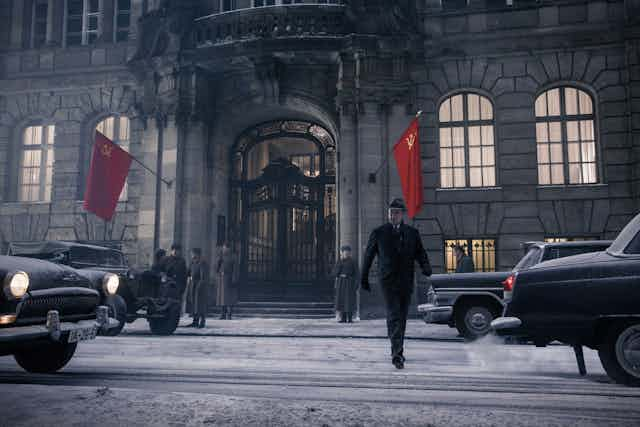The problem with writing the history of the secret world of spies is that so much of their story is just that – secret. Despite the fact that the Cold War ended a generation ago, governments are still reluctant to declassify the files that would allow us finally to answer the many unsolved and unknown questions of that era.
This is slightly less of a problem for Steven Spielberg in his latest film, Bridge of Spies, as he tells the Cold War story of a secret mission that ended in a very public way. The film follows humble insurance lawyer James Donovan (Tom Hanks), a man reviled by America for taking on the legal defence of Soviet spy Rudolph Abel (Mark Rylance, who quietly steals the show) in the US state’s case against him.
Things get complicated when another prisoner enters the drama – this time a US pilot, Francis Gary Powers, who joined the U-2 spying programme in the late 1950s. Powers flew U-2 planes over the Soviet Union in order to photograph huge swathes of territory and glean an understanding of the communist state’s industrial capabilities. But his plane was hit by a Soviet surface-to-air missile in May 1960 as he flew over a nuclear facility near the town of Sverdlovsk. He survived, was arrested and tried in Moscow, where he was found guilty and sentenced to ten years “deprivation of liberty”.

The incident was a real flashpoint in US-Soviet relations. At the time, Eisenhower and Khrushchev were both looking for ways to improve dealings between their countries, but this episode increased tension. Strangely, however, it was not the politicians or diplomats who defused the situation, but Donovan who conducted the negotiations to get Powers returned to the US in exchange for Soviet prisoner Rudolph Abel.
American everyman to the rescue
This story, of a man caught between the two nuclear rivals, gave me hope that we’d be treated to a more balanced portrayal of Cold War brinkmanship.
The opening scene is promising. We see Abel, the Soviet spy, painting a self-portrait. The camera draws back slowly, allowing us to see the portrait, then the reflection of the subject in the mirror, and finally the man in reality. I wondered if this shot was setting up a film that would examine the ambiguous nature of the life of a spy – hero, traitor, celebrity, nonentity – and whether Spielberg might attempt a more nuanced approach to the multiple readings of that historical period.

However, from there on in, the film follows a more familiar route. Although it is hardly a prejudiced interpretation of the Cold War and the relationship between Donovan and Abel is tinged with mutual respect throughout, Bridge of Spies largely ignores the Soviet side of things. A Cold War historian would be very unlikely to write an account of this episode that focused only on the actions of one of the nations involved, yet that is roughly what we get.
As Donovan travels further into the dark heart of US-Soviet relations, it is clear that he alone has the fate of the two men in his hands, and he who is the real hero. He’s the typical American everyman, a regular guy with an old-fashioned sense of fairness and an oft-voiced penchant for the American constitution. Donovan’s sense of fairness drives the film, with some stirring speeches about human rights which strike a timely, contemporary note.
The action on the screen is reasonably true to the real events, although there is a great deal missing from the story, not least the Paris Summit of 1960. The summit, arranged to discuss the escalating Cold War, was held just as news broke across the world of Powers’ arrest. Khrushchev immediately demanded an apology from Eisenhower over the U-2 incident and when one was not delivered, the enraged Soviet leader went back to Moscow.
Perhaps I was expecting too much of Spielberg. After all, we are presented with an accurate portrait of the world of spies during that remarkable period, a million miles from the cartoon capers of the latest James Bond movie. There’s a riot of brilliant period detail. This really was the golden age of spying, and the film is peppered with both the exciting and the banal sides of the life of a spook: the dead drops, the codes, the pin tipped with lethal poison, but also the waiting, the anxiety, and the shame of capture.
The visual representation of the wider Cold War era is also striking, from American children practising the “duck and cover” routine in class, down to the portrait of Khrushchev, standing in a field of his beloved corn, that hangs in the office of the Russian embassy in Berlin.
But while the details in Bridge of Spies are just right, the bigger picture lacks real depth. Nevertheless, Spielberg is at his best when portraying a simple battle of good versus evil, and this film is essentially just that – the story of a hero triumphing against the odds.
Bridge of Spies is released in the UK on November 27.

